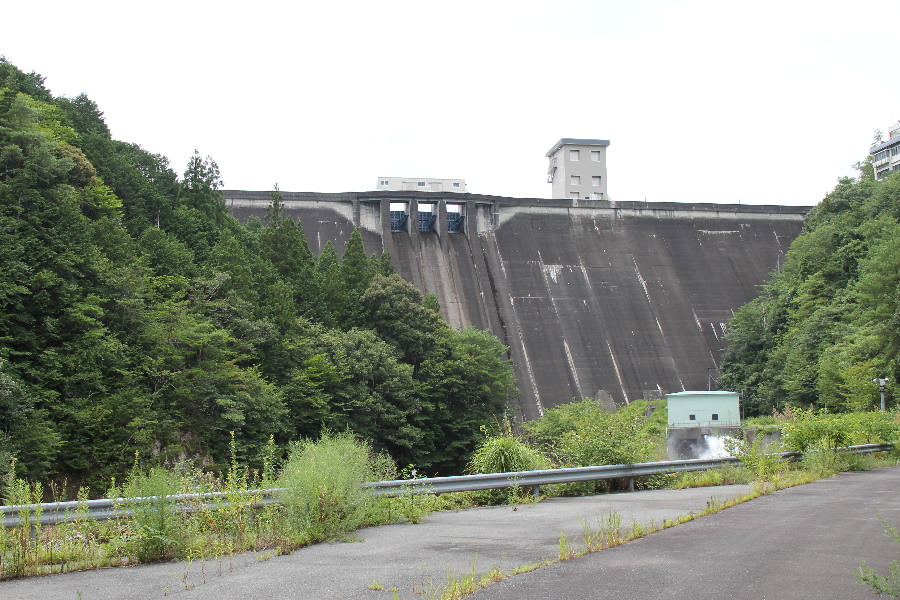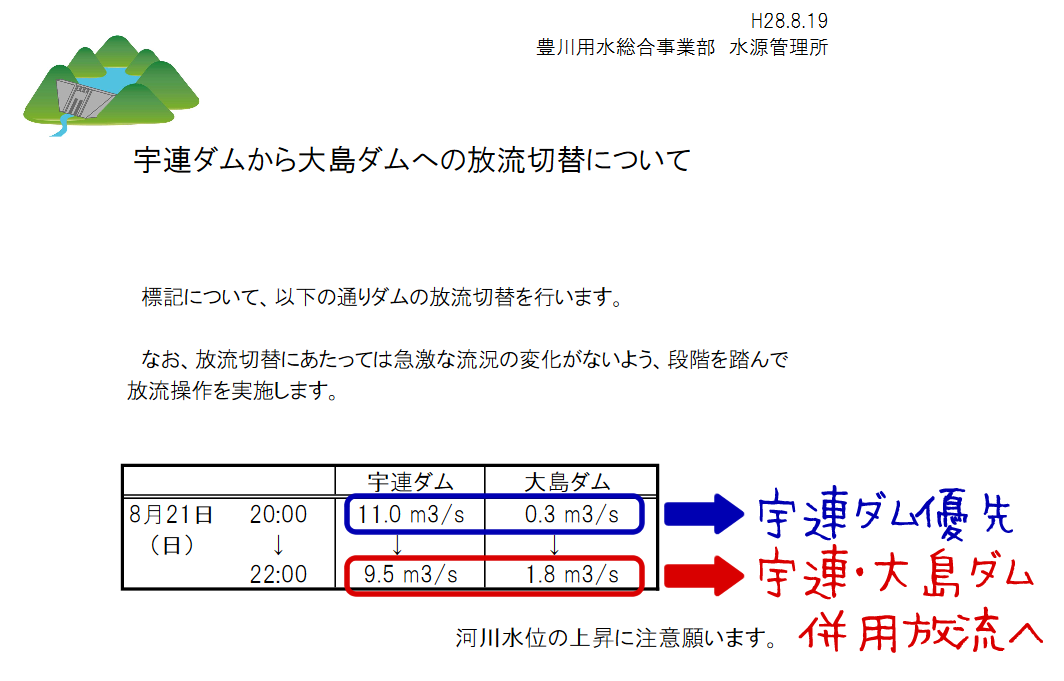I've been operating under a subdomain, "Damlog :: damlogThe articles in this site have been mostly neglected (and so has Damapedia), and due to various problems, we have decided to merge them into Damapedia. I have not yet decided whether or not to migrate past articles (it's a pain in the ass). Thanks, it's time for the dam log.
Now, let's get down to business.
It all started with this tweet.
The current water storage rate is 6.51 TP3T (14:00)
- Uren Dam Water Reservoir (@ure_dam) September 5, 2016
The figures shown by BOT, which regularly informs the water storage rate of Uren Dam in Higashimikawa, Aichi Prefecture. It is very low.
It's quite a critical situation. Oshima is also decreasing a bit.
- Shin Shin@ Kamimadammeister (@dampedia) September 5, 2016
When I tweeted, "I'm so glad to hear that," I immediately received a reply from Mr. Hoshino, a well-known flooding expert. Here is the exchange.
@dampedia You are switching to Uren in June!https://t.co/nNpFFMSbff What is the operation of this area?
- Yuho Hoshino (@choidamnet) September 5, 2016
@choidamnet I wonder if this is a date/time limited response?
- Shin Kamma @Dammeister (@dampedia) September 5, 2016
@dampedia There has been no press release since then.
- Yuho Hoshino (@choidamnet) September 5, 2016
@choidamnet Most recently, on August 19, they switched the discharge from the Uren Dam to the Oshima Dam for 2 hours, but I have no idea what the switchover discharge was for. The only way to find out is to contact them directly! https://t.co/bWqKhUVH6G
- Shin Kamma @Dammeister (@dampedia) September 5, 2016
@dampedia Best regards: !!!!!!!
- Yuho Hoshino (@choidamnet) September 5, 2016
@choidamnet Eww.
- Shin Kamma @Dammeister (@dampedia) September 5, 2016
So, for some reason, I'm going to inquire w
Incidentally, Uren Dam and Oshima Dam frequently switch their discharge. (See alsoToyokawa Water Supply Homepage)
The first inquiry is as follows.
Q1: It seems that you often switch the discharge between Uren Dam and Oshima Dam. I assume it is to maintain the Uren and Oshima Rivers.
Here is the response from the Water Resources Agency, Japan, Toyokawa Water Supply Division.
Uren Dam and Oshima Dam are water diversion dams.
No discharge is made for river maintenance, but for replenishment of water supply. Currently, each dam is designed to have a free capacity so that rainfall can be effectively stored, because if each dam is always full, there may be cases of invalid discharge.
The switchover discharge is made from one dam to another in order to secure the available capacity.
I was so embarrassed that I wrote "I guessed it was for river maintenance" even though there is no use for river maintenance. However, although I received a reply, I have more and more questions.
- . free capacity for the effective storage of rainfall."
But I am not sure if it is correct to recognize that the one with the higher water storage capacity is given priority for discharge... In other words, what are the criteria for performing the switchover discharge? - Regarding "invalid discharge may occur when each dam is full," for example, at that time, the Oshima Dam is at high storage capacity, but we feel this is somewhat inconsistent with releasing water to secure available capacity.
- The switchover discharge was conducted from 8pm to 10pm on 8/21, but the basic question is whether this means "switch over 2 hours" or "switch only for 2 hours and then switch back".
- The Uren Dam had a discharge rate of 9.5 m3/s at the time, but the replenishment rate of the Uren Dam written in the "Water Source Status (Water Use)" section of the Toyokawa Water Supply website is "0.5 m3/s." Is it correct to understand that the discharge rate and replenishment rate are different?
- I wanted to check how the discharge rates of the Uren and Oshima dams have changed in the wake of this incident, but the Ministry of Land, Infrastructure, Transport and Tourism's river disaster prevention information and hydrologic quality database do not list the discharge rates.
Also, when it came to the Oshima Dam, there was no entry for the dam itself. I wonder if there is any reason for this.
It took a few days to reply to these as additional questions immediately. I received a response and I will share it below with an explanation. I am trying to be clear, but I apologize if it is difficult to understand.
Q2: When you say, "free capacity for effective storage of rainfall," am I correct in understanding that the higher storage volume is given priority for discharge?
Uren Dam and Oshima Dam are the source of water for the Toyokawa River, and are dams dedicated to water utilization.
Water intake points (Ono Headworks and Muro Matsubara)weir (usu. for irrigation)In the event that the river's own flow (including water conveyed by changes to the watershed) is insufficient to supply the required amount of water, the water is released from the dam.
How the water is released from either dam is determined based on the characteristics of each dam.
Basically, the Uren Dam was developed first and the Oshima Dam was added to compensate for the shortage, so the plan is to give priority to the Uren Dam. When the Oshima Dam becomes free enough to store the inflow of one rainfall, it will be switched to use of the Uren Dam, and when the Oshima Dam also becomes free enough to store one rainfall, the Uren Dam will be returned to priority discharge.
Note that the size of the available capacity for a single rainfall varies depending on the characteristics of both dams (size and rainfall characteristics of the direct catchment basin, presence of an indirect basin, etc.).
When the storage capacity of the Uren Dam drops to the same level as that of the Oshima Dam, the prioritized discharge from the Uren Dam will be replaced by a combined discharge from the Uren and Oshima Dams (discharge in a ratio that takes into account the characteristics of both dams).
First, the basic premise of the discharge is that when the water flowing into the river at the intake points (Ono Headworks and Muro Matsubara Headworks) is not enough, water is replenished from the Uren Dam and Oshima Dam.
By the way, as an addendum, "including water-conducted by watershed changes" probably refers to the Sakuma conduit, right?
However, when one rainfall is released, the Oshima Dam releases water, and when the Oshima Dam also releases one rainfall, the discharge is returned to the Uren Dam......and so on.
However, this will not continue forever, and when the storage capacity of the Uren Dam drops to the same level as that of the Oshima Dam, water will be released from both dams.
Q3: You mentioned that "when each dam is full, invalid releases may occur," but I feel that this is somewhat inconsistent with, for example, the current high storage capacity of the Oshima Dam, which releases water in order to secure available capacity. What do you think about this area?
As per answer 1.
Note that "discharge to free up capacity" is only the discharge of water that is insufficient to meet the water requirements at the point of intake.
In other words, we are not just releasing the water, but we are operating on the assumption that we are making up for the shortage.
...I'm a little worried that the people inside might think, "He's so stupid.
Q4. Most recently, you are implementing a switchover discharge from 8pm to 10pm on 8/21. Is this a "switchover over 2 hours" or "switch only for 2 hours and then return to normal"?
The reason I ask this question is due to my lack of understanding of the question.
I kind of feel like it is river maintenance for the Oshima and Uren Rivers. So that the flow rate of the main stream of the Toyokawa River and the storage capacity of both dams will not be affected. But only for 2 hours or what's the point?
- Shin Kamma @Dammeister (@dampedia) September 5, 2016
From the beginning, I saw the notice and mistakenly thought that we were only supposed to do that discharge for the stated time.
The switchover discharge on August 21 was a two-hour operation to switch from the previous method of releasing water with priority on the Uren Dam to a method of releasing water using both dams together.
This means that they have switched to the following operations.
And from our followers, too.
@dampedia Excuse me for not following you.
I believe that this was not a switch for only two hours, but rather a switch in the discharge of both dams over a two-hour period.
I think the discharge rate of Uren dam was 9.3 m3/s after Aug. 19.- Noike (@WanderingNoike) September 5, 2016
You pointed out that this person's explanation was correct.
Q5: If the answer to the above question is the former, then the Uren Dam is currently discharging 9.5 m3/s, but the replenishment rate of the Uren Dam is "0.5 m3/s" as written in the "Water Source Status (Water Use)" section of the Toyokawa Waterworks website. Am I correct in assuming that the amount of water discharged and the amount replenished are two different things?
It is a little difficult to understand the meaning of the question, so I would like to add that as of 22:00 on 8/21, as shown in the image above, it says "The discharge rate of Uren Dam will be 9.5m3/s", but on 9/7, the Toyokawa Waterworks website says "The discharge rate of Uren Dam will be 9.5m3/s".Water source status (water utilization)I wanted to ask if the "dam replenishment volume" figure written in "0.5 m3/s" in the "Dam replenishment volume" section means the same thing as the "discharge volume" and the "replenishment volume" written in these sections.
The answer is below.
The "Utsure Dam to Oshima Dam Release Switch" notice is posted only at the time of the switchover, when river flow conditions are expected to change in the direction of a large increase.
For this reason, no notice is given at the time of subsequent changes to the water diversion discharge.
The 9.5 m3/s is the amount of usable water discharge as of 8/21 and 0.5 m3/s as of 9/7.
After the announcement, they will not update the announcement unless the discharge changes significantly. Also, although not explicitly stated, it seems that "discharge = replenishment".
(...I'm starting to get somewhat worried that the people inside are getting annoyed with me...)
Q6: I would like to check the discharge rate in the past, but there is no information on the discharge rate in the Ministry of Land, Infrastructure, Transport and Tourism's river disaster prevention information or hydrological quality database, and in the case of Oshima Dam, there is no entry for the dam itself.
This is a little unrelated to the main question, but I asked it somewhat bluntly because I had no way of knowing the amount of past discharges when I tried to get an answer to Q5 myself.
Since the Uren Dam and Oshima Dam are dams exclusively used for water utilization for the Toyokawa River, ETIC does not include them in the Ministry of Land, Infrastructure, Transport and Tourism's river disaster prevention information. Please contact the Ministry of Land, Infrastructure, Transport and Tourism for information on the Uren Dam.
This was the expected answer. But, for example, the Water Authority-owned, which does not have flood control functions.Kiso River weir (Varanus kisogawai, species of carnivorous bird found in Japan and Taiwan)is on the river disaster prevention information, isn't it? I would like to ask the Ministry of Land, Infrastructure, Transport and Tourism about this when I have a chance.
So, Kamima felt that he had become one wiser about the Toyokawa water supply.
Thank you very much for taking time out of your busy schedule to answer our questions, Mr. Toyokawa Water Supply Project Department, Japan Water Agency.





Comment
Thank you I almost understand.
>Subsidy.
Thank you for your comment.
Glad you understand!